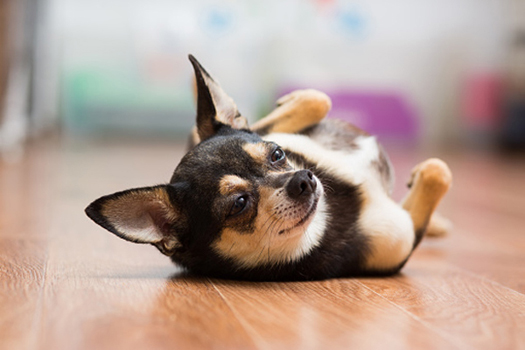Our Services
Dog Behavior
We can assist in identifying the root causes of problems like separation anxiety and compulsive behaviour in order to create a productive, compassionate training regimen.

Dog Behavior
Dog behavior problems are often misunderstood. Thoroughly understanding the most common dog behavior problems is the first step to solving and preventing them.
Common Dog Behavior Problems:
- Barking
- Chewing
- Jumping
- Aggression
Understanding Your Dog's Barking
Most dogs will vocalize in one way or another. They may bark, howl, and whine. Excessive barking is considered a behavior problem.
The most common types of barking are:
- Warning or Alert
- Playfulness and Excitement
- Attention-Seeking
- Anxiety
Consider teaching them bark/quiet commands. Be consistent and patient. Exercise daily to ensure they’re getting enough mental or physical exercise. Don’t reward your dog for barking. Reward them for staying quiet instead.
Understanding Your Dog's Chewing
Chewing is a natural for all dogs. It’s normal for puppies and dogs to chew on objects as they explore the world. For puppies, it’s a way to relieve pain that might be caused by incoming teeth (like human babies with teethers). Chewing also combats boredom and can relieve mild anxiety or frustration. Excessive chewing can quickly become a behavior problem if your dog causes destruction.
The most common reasons dogs’ chew:
- Puppy Teething
- Boredom
- Anxiety
- Curiosity
Provide and encourage your dog to chew on the right things by providing plenty of appropriate chew toys. Keep personal items away from your dog. When you are not home, crate train your dog or confine them to an area where less destruction can be caused.
If you see your dog chewing the wrong item, quickly distract your dog. Then, replace the item with an appropriate chew toy. One of the most important things you can do is to make sure your dog gets plenty of exercise so it can wear off energy and be stimulated in that way rather than turning to chewing.
Understanding Your Dog's Jumping
Dogs jump for all kinds of reasons: attention, excitement or not knowing what else to do when they see a person. A jumping dog can be annoying and even dangerous. Jumping up is often attention-seeking behavior, so any acknowledgment of your dog’s actions provides an instant reward, reinforcing the jumping. Teach your dog that they receive no attention for jumping on you or anyone else. You can turn your back and only pet your dog when all four paws are on the floor and they remain still, then calmly reward him. It won’t take long before your dog gets the message.
Training Your Dog to Stop Jumping on People: A Step-by-Step Guide
Here are some tips to help you train your dog to stop jumping on people:
- Ask a family member or friend that your dog likes to assist with training. Your dog should never be forced to greet someone who scares them.
- Give your dog the “sit” command. (Assuming your dog already knows how to “sit.”)
- The greeter approaches you and your dog. If your dog stands up, the greeter immediately turns and walks away.
- Ask your dog to “sit” and have the greeter approach again.
- Keep repeating the previous step until your dog remains seated as the greeter approaches.
- If your dog remains seated, reward them with a treat.
- When you’re walking your dog and encounter someone, stop the person from approaching by telling them that your dog may jump. Hand the person a treat or get a treat ready in your hand to reward your pup for good behavior. Ask your dog to “sit” and tell the person they can pet your dog and give them the treat as long as your dog remains seated.
- Keep greetings quiet and low-key to avoid your dog getting too excited. If your dog jumps on you when you come in the door, ignore them and turn around to go out the door. Try again until your dog learns to keep all four feet on the ground.
- If your dog jumps on you while you’re sitting, stand up and ignore them until all four feet are on the ground.
Remember, consistency is key when training your dog. Stick to your training and don’t let anyone encourage your dog to jump, even if they say they don’t mind. With patience and perseverance, your dog can learn to greet people without jumping on them.
Understanding Your Dog's Aggression
Aggression is one of the most common reasons pet owners seek professional help for their dogs. It’s important to determine the cause of aggression to deal appropriately with the issue at hand.
What Are Some Types of Aggression?
- Territorial Aggression – directed towards a person or animal that enters and/or approaches the dog’s perceived territory, which typically is usually the owner’s home or property
- Possessive Aggression (Resource Guarding) – towards a person or animal when the dog feels threatened that the person or animal will take away something of value (food or toys)
- Pain-Related Aggression – directed towards a person or animal which is motivated by pain or discomfort
- Redirected Aggression – occurs when a dog cannot reach their target of its aggression (person or animal) and out of frustration changes its focus to another object, person, or other animal
- Fear or Anxiety-Related Aggression – directed towards a person or animal motivated by feeling afraid, which may occur if approached, if they feel cornered or trapped
- Predatory Aggression – directed typically toward another animal, and is motivated by the desire to hunt and capture a species viewed as prey. Predatory aggression is typically absent of vocalizations and the bite is often damaging.
